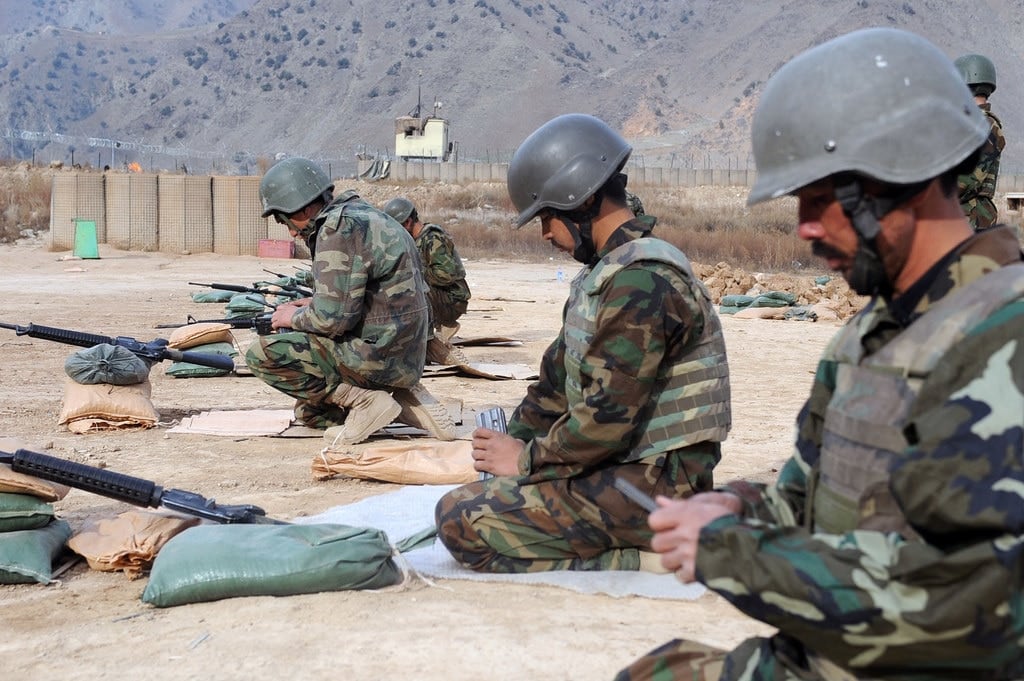KABUL, Afghanistan — An uptick in attacks by Afghan National army soldiers against foreign troops would seem a worrisome trend ahead of the deployment of another 4,000 U.S. troops to Afghanistan in the latest attempt by Washington to turn around the protracted war against insurgents.
Two so-called insider attacks, in which a soldier in an Afghan National Army uniform turns his weapon on foreign troops, in as many weeks have killed three U.S. soldiers and wounded another seven.
Insider attacks have been occurring with deadly regularity since 2011. According to an April report by the Modern War Institute at America's West Point it was in 2011 that "insider attacks became the preferred war-fighting tactic of the Taliban, an organization that understood well how to apply limited resources for maximum effect."
The report says since 2007, insider attacks have killed 157 NATO personnel and 557 members of the Afghan National Defense and Security Forces. But it also blames many attacks against foreign troops on what it calls cultural friction, where Afghans become infuriated by a perceived insult.
In June alone there were two separate attacks on U.S. soldiers by Afghans wearing an Afghan army uniform. In March another insider attack killed three U.S. soldiers. In April, Taliban fighters dressed in Afghan army uniforms passed through several security rings to enter a base in northern Afghanistan's Balkh province and kill as many as 140 Afghan soldiers.
The attacks come as U.S. President Donald Trump prepares to bolster Washington's presence in Afghanistan to stem the violence and the Taliban's military advances, particularly in rural areas of the country, and largely in the south and the east. But the emergence of an affiliate of the Islamic State group has created a sense of urgency to turn the war around.
WHAT HAVE THE LATEST INSIDER ATTACKS LOOKED LIKE AND WHAT DO THEY SAY ABOUT INSURGENTS' ABILITY TO INFILTRATE?
The diverse locations of the two most recent insider attacks shows the depth of reach now available to insurgents, with one attack taking place in eastern Nangarhar province and the second in northern Afghanistan's Balkh province.
Eastern Nangarhar province is understood to be one of the most dangerous regions of Afghanistan, where both the Taliban and the upstart IS affiliate operate. It also borders neighbor Pakistan and has been the scene of the heavy fighting and where the United States last month dropped the largest non-nuclear bomb in its arsenal. The target was the IS affiliate.
In the deadliest attack in Achin in eastern Nangarhar province, three U.S. soldiers were killed when an Afghan soldier emptied his automatic rifle in their direction. There was no earlier indication of his intent. He was also killed.
The most recent attack which took place Saturday occurred in northern Afghanistan where the Taliban have been making inroads, moving beyond their traditional support base in the south and east of Afghanistan.
When the Taliban announced the start of their spring offensive they took particular aim "on foreign forces, their military and intelligence infrastructure and in eliminating their internal mercenary apparatus." They said one of the tools they would employ to carry out their strategy would be insider attacks. Since the start of their spring offensive three insider attacks have occurred, compared to the two carried out last year.

Afghan National Army soldiers load ammunition into their magazines for a weapons qualification with the M16 A1 rifle on FOB Bostick at Bostick Afghanistan, Jan. 16, 2007.
Photo Credit: Army
WHAT MIGHT PROMPT AN AFGHAN ARMY SOLDIER TO TURN HIS WEAPON ON FOREIGN TROOPS WHO ARE IN AFGHANISTAN AS ALLIES AND TO PROVIDE MILITARY SUPPORT?
The report by West Point's Modern War Institute entitled "Dress Like Allies, Kill Like Enemies" said the reason for insider attacks is a mix of "cultural friction" that results in a perceived insult and Taliban infiltration. A second report done in 2011 by U.S. military psychologists and behavioral scientists, who interviewed dozens of Afghan and American soldiers, discovered a dramatic cultural disconnect, with most Afghan soldiers feeling mistreated and insulted by their American allies.
According to that report, A Crisis of Trust and Cultural Incompatibility, Afghans "found many U.S. soldiers to be extremely arrogant, bullying, unwilling to listen to their advice, and were often seen as lacking concern for civilian and ANSF (Afghan National Security Forces) safety during combat."
The same report said the perception of U.S. soldiers toward their Afghan allies was equally unflattering. U.S. troops accused their Afghan allies of "pervasive illicit drug use, massive thievery, personal instability, dishonesty, no integrity, incompetence, unsafe weapons handling, corrupt officers ... high AWOL rates, bad morale, laziness (and) repulsive hygiene." They were equally unflattering of civilians whom they said were often sympathetic toward insurgents.
The 2017 report by West Point's Modern War Institute would indicate that little has changed, saying that 40 percent of the 102 insider attacks that occurred between 2007 and 2016 was the result of a personal grievance, while 25 percent the result of Taliban infiltration.
Still there does appear to be attempts to bridge the divide and reduce easy access by insurgents with a much improved vetting process for Afghan soldiers entering the army and stepped up efforts to build relationships and reduce cultural understandings on both sides.
Gannon reported from Islamabad, Pakistan.




